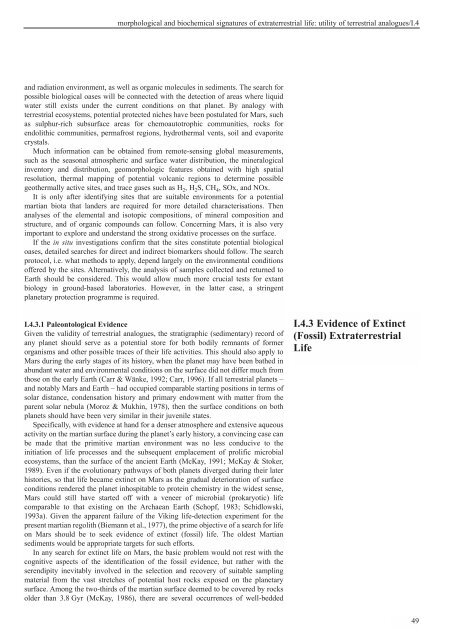Exobiology in the Solar System & The Search for Life on Mars - ESA
Exobiology in the Solar System & The Search for Life on Mars - ESA
Exobiology in the Solar System & The Search for Life on Mars - ESA
You also want an ePaper? Increase the reach of your titles
YUMPU automatically turns print PDFs into web optimized ePapers that Google loves.
morphological and biochemical signatures of extraterrestrial life: utility of terrestrial analogues/I.4<br />
and radiati<strong>on</strong> envir<strong>on</strong>ment, as well as organic molecules <str<strong>on</strong>g>in</str<strong>on</strong>g> sediments. <str<strong>on</strong>g>The</str<strong>on</strong>g> search <str<strong>on</strong>g>for</str<strong>on</strong>g><br />
possible biological oases will be c<strong>on</strong>nected with <str<strong>on</strong>g>the</str<strong>on</strong>g> detecti<strong>on</strong> of areas where liquid<br />
water still exists under <str<strong>on</strong>g>the</str<strong>on</strong>g> current c<strong>on</strong>diti<strong>on</strong>s <strong>on</strong> that planet. By analogy with<br />
terrestrial ecosystems, potential protected niches have been postulated <str<strong>on</strong>g>for</str<strong>on</strong>g> <strong>Mars</strong>, such<br />
as sulphur-rich subsurface areas <str<strong>on</strong>g>for</str<strong>on</strong>g> chemoautotrophic communities, rocks <str<strong>on</strong>g>for</str<strong>on</strong>g><br />
endolithic communities, permafrost regi<strong>on</strong>s, hydro<str<strong>on</strong>g>the</str<strong>on</strong>g>rmal vents, soil and evaporite<br />
crystals.<br />
Much <str<strong>on</strong>g>in</str<strong>on</strong>g><str<strong>on</strong>g>for</str<strong>on</strong>g>mati<strong>on</strong> can be obta<str<strong>on</strong>g>in</str<strong>on</strong>g>ed from remote-sens<str<strong>on</strong>g>in</str<strong>on</strong>g>g global measurements,<br />
such as <str<strong>on</strong>g>the</str<strong>on</strong>g> seas<strong>on</strong>al atmospheric and surface water distributi<strong>on</strong>, <str<strong>on</strong>g>the</str<strong>on</strong>g> m<str<strong>on</strong>g>in</str<strong>on</strong>g>eralogical<br />
<str<strong>on</strong>g>in</str<strong>on</strong>g>ventory and distributi<strong>on</strong>, geomorphologic features obta<str<strong>on</strong>g>in</str<strong>on</strong>g>ed with high spatial<br />
resoluti<strong>on</strong>, <str<strong>on</strong>g>the</str<strong>on</strong>g>rmal mapp<str<strong>on</strong>g>in</str<strong>on</strong>g>g of potential volcanic regi<strong>on</strong>s to determ<str<strong>on</strong>g>in</str<strong>on</strong>g>e possible<br />
geo<str<strong>on</strong>g>the</str<strong>on</strong>g>rmally active sites, and trace gases such as H 2, H 2S, CH 4, SOx, and NOx.<br />
It is <strong>on</strong>ly after identify<str<strong>on</strong>g>in</str<strong>on</strong>g>g sites that are suitable envir<strong>on</strong>ments <str<strong>on</strong>g>for</str<strong>on</strong>g> a potential<br />
martian biota that landers are required <str<strong>on</strong>g>for</str<strong>on</strong>g> more detailed characterisati<strong>on</strong>s. <str<strong>on</strong>g>The</str<strong>on</strong>g>n<br />
analyses of <str<strong>on</strong>g>the</str<strong>on</strong>g> elemental and isotopic compositi<strong>on</strong>s, of m<str<strong>on</strong>g>in</str<strong>on</strong>g>eral compositi<strong>on</strong> and<br />
structure, and of organic compounds can follow. C<strong>on</strong>cern<str<strong>on</strong>g>in</str<strong>on</strong>g>g <strong>Mars</strong>, it is also very<br />
important to explore and understand <str<strong>on</strong>g>the</str<strong>on</strong>g> str<strong>on</strong>g oxidative processes <strong>on</strong> <str<strong>on</strong>g>the</str<strong>on</strong>g> surface.<br />
If <str<strong>on</strong>g>the</str<strong>on</strong>g> <str<strong>on</strong>g>in</str<strong>on</strong>g> situ <str<strong>on</strong>g>in</str<strong>on</strong>g>vestigati<strong>on</strong>s c<strong>on</strong>firm that <str<strong>on</strong>g>the</str<strong>on</strong>g> sites c<strong>on</strong>stitute potential biological<br />
oases, detailed searches <str<strong>on</strong>g>for</str<strong>on</strong>g> direct and <str<strong>on</strong>g>in</str<strong>on</strong>g>direct biomarkers should follow. <str<strong>on</strong>g>The</str<strong>on</strong>g> search<br />
protocol, i.e. what methods to apply, depend largely <strong>on</strong> <str<strong>on</strong>g>the</str<strong>on</strong>g> envir<strong>on</strong>mental c<strong>on</strong>diti<strong>on</strong>s<br />
offered by <str<strong>on</strong>g>the</str<strong>on</strong>g> sites. Alternatively, <str<strong>on</strong>g>the</str<strong>on</strong>g> analysis of samples collected and returned to<br />
Earth should be c<strong>on</strong>sidered. This would allow much more crucial tests <str<strong>on</strong>g>for</str<strong>on</strong>g> extant<br />
biology <str<strong>on</strong>g>in</str<strong>on</strong>g> ground-based laboratories. However, <str<strong>on</strong>g>in</str<strong>on</strong>g> <str<strong>on</strong>g>the</str<strong>on</strong>g> latter case, a str<str<strong>on</strong>g>in</str<strong>on</strong>g>gent<br />
planetary protecti<strong>on</strong> programme is required.<br />
I.4.3.1 Pale<strong>on</strong>tological Evidence<br />
Given <str<strong>on</strong>g>the</str<strong>on</strong>g> validity of terrestrial analogues, <str<strong>on</strong>g>the</str<strong>on</strong>g> stratigraphic (sedimentary) record of<br />
any planet should serve as a potential store <str<strong>on</strong>g>for</str<strong>on</strong>g> both bodily remnants of <str<strong>on</strong>g>for</str<strong>on</strong>g>mer<br />
organisms and o<str<strong>on</strong>g>the</str<strong>on</strong>g>r possible traces of <str<strong>on</strong>g>the</str<strong>on</strong>g>ir life activities. This should also apply to<br />
<strong>Mars</strong> dur<str<strong>on</strong>g>in</str<strong>on</strong>g>g <str<strong>on</strong>g>the</str<strong>on</strong>g> early stages of its history, when <str<strong>on</strong>g>the</str<strong>on</strong>g> planet may have been ba<str<strong>on</strong>g>the</str<strong>on</strong>g>d <str<strong>on</strong>g>in</str<strong>on</strong>g><br />
abundant water and envir<strong>on</strong>mental c<strong>on</strong>diti<strong>on</strong>s <strong>on</strong> <str<strong>on</strong>g>the</str<strong>on</strong>g> surface did not differ much from<br />
those <strong>on</strong> <str<strong>on</strong>g>the</str<strong>on</strong>g> early Earth (Carr & Wänke, 1992; Carr, 1996). If all terrestrial planets –<br />
and notably <strong>Mars</strong> and Earth – had occupied comparable start<str<strong>on</strong>g>in</str<strong>on</strong>g>g positi<strong>on</strong>s <str<strong>on</strong>g>in</str<strong>on</strong>g> terms of<br />
solar distance, c<strong>on</strong>densati<strong>on</strong> history and primary endowment with matter from <str<strong>on</strong>g>the</str<strong>on</strong>g><br />
parent solar nebula (Moroz & Mukh<str<strong>on</strong>g>in</str<strong>on</strong>g>, 1978), <str<strong>on</strong>g>the</str<strong>on</strong>g>n <str<strong>on</strong>g>the</str<strong>on</strong>g> surface c<strong>on</strong>diti<strong>on</strong>s <strong>on</strong> both<br />
planets should have been very similar <str<strong>on</strong>g>in</str<strong>on</strong>g> <str<strong>on</strong>g>the</str<strong>on</strong>g>ir juvenile states.<br />
Specifically, with evidence at hand <str<strong>on</strong>g>for</str<strong>on</strong>g> a denser atmosphere and extensive aqueous<br />
activity <strong>on</strong> <str<strong>on</strong>g>the</str<strong>on</strong>g> martian surface dur<str<strong>on</strong>g>in</str<strong>on</strong>g>g <str<strong>on</strong>g>the</str<strong>on</strong>g> planet’s early history, a c<strong>on</strong>v<str<strong>on</strong>g>in</str<strong>on</strong>g>c<str<strong>on</strong>g>in</str<strong>on</strong>g>g case can<br />
be made that <str<strong>on</strong>g>the</str<strong>on</strong>g> primitive martian envir<strong>on</strong>ment was no less c<strong>on</strong>ducive to <str<strong>on</strong>g>the</str<strong>on</strong>g><br />
<str<strong>on</strong>g>in</str<strong>on</strong>g>itiati<strong>on</strong> of life processes and <str<strong>on</strong>g>the</str<strong>on</strong>g> subsequent emplacement of prolific microbial<br />
ecosystems, than <str<strong>on</strong>g>the</str<strong>on</strong>g> surface of <str<strong>on</strong>g>the</str<strong>on</strong>g> ancient Earth (McKay, 1991; McKay & Stoker,<br />
1989). Even if <str<strong>on</strong>g>the</str<strong>on</strong>g> evoluti<strong>on</strong>ary pathways of both planets diverged dur<str<strong>on</strong>g>in</str<strong>on</strong>g>g <str<strong>on</strong>g>the</str<strong>on</strong>g>ir later<br />
histories, so that life became ext<str<strong>on</strong>g>in</str<strong>on</strong>g>ct <strong>on</strong> <strong>Mars</strong> as <str<strong>on</strong>g>the</str<strong>on</strong>g> gradual deteriorati<strong>on</strong> of surface<br />
c<strong>on</strong>diti<strong>on</strong>s rendered <str<strong>on</strong>g>the</str<strong>on</strong>g> planet <str<strong>on</strong>g>in</str<strong>on</strong>g>hospitable to prote<str<strong>on</strong>g>in</str<strong>on</strong>g> chemistry <str<strong>on</strong>g>in</str<strong>on</strong>g> <str<strong>on</strong>g>the</str<strong>on</strong>g> widest sense,<br />
<strong>Mars</strong> could still have started off with a veneer of microbial (prokaryotic) life<br />
comparable to that exist<str<strong>on</strong>g>in</str<strong>on</strong>g>g <strong>on</strong> <str<strong>on</strong>g>the</str<strong>on</strong>g> Archaean Earth (Schopf, 1983; Schidlowski,<br />
1993a). Given <str<strong>on</strong>g>the</str<strong>on</strong>g> apparent failure of <str<strong>on</strong>g>the</str<strong>on</strong>g> Vik<str<strong>on</strong>g>in</str<strong>on</strong>g>g life-detecti<strong>on</strong> experiment <str<strong>on</strong>g>for</str<strong>on</strong>g> <str<strong>on</strong>g>the</str<strong>on</strong>g><br />
present martian regolith (Biemann et al., 1977), <str<strong>on</strong>g>the</str<strong>on</strong>g> prime objective of a search <str<strong>on</strong>g>for</str<strong>on</strong>g> life<br />
<strong>on</strong> <strong>Mars</strong> should be to seek evidence of ext<str<strong>on</strong>g>in</str<strong>on</strong>g>ct (fossil) life. <str<strong>on</strong>g>The</str<strong>on</strong>g> oldest Martian<br />
sediments would be appropriate targets <str<strong>on</strong>g>for</str<strong>on</strong>g> such ef<str<strong>on</strong>g>for</str<strong>on</strong>g>ts.<br />
In any search <str<strong>on</strong>g>for</str<strong>on</strong>g> ext<str<strong>on</strong>g>in</str<strong>on</strong>g>ct life <strong>on</strong> <strong>Mars</strong>, <str<strong>on</strong>g>the</str<strong>on</strong>g> basic problem would not rest with <str<strong>on</strong>g>the</str<strong>on</strong>g><br />
cognitive aspects of <str<strong>on</strong>g>the</str<strong>on</strong>g> identificati<strong>on</strong> of <str<strong>on</strong>g>the</str<strong>on</strong>g> fossil evidence, but ra<str<strong>on</strong>g>the</str<strong>on</strong>g>r with <str<strong>on</strong>g>the</str<strong>on</strong>g><br />
serendipity <str<strong>on</strong>g>in</str<strong>on</strong>g>evitably <str<strong>on</strong>g>in</str<strong>on</strong>g>volved <str<strong>on</strong>g>in</str<strong>on</strong>g> <str<strong>on</strong>g>the</str<strong>on</strong>g> selecti<strong>on</strong> and recovery of suitable sampl<str<strong>on</strong>g>in</str<strong>on</strong>g>g<br />
material from <str<strong>on</strong>g>the</str<strong>on</strong>g> vast stretches of potential host rocks exposed <strong>on</strong> <str<strong>on</strong>g>the</str<strong>on</strong>g> planetary<br />
surface. Am<strong>on</strong>g <str<strong>on</strong>g>the</str<strong>on</strong>g> two-thirds of <str<strong>on</strong>g>the</str<strong>on</strong>g> martian surface deemed to be covered by rocks<br />
older than 3.8 Gyr (McKay, 1986), <str<strong>on</strong>g>the</str<strong>on</strong>g>re are several occurrences of well-bedded<br />
I.4.3 Evidence of Ext<str<strong>on</strong>g>in</str<strong>on</strong>g>ct<br />
(Fossil) Extraterrestrial<br />
<str<strong>on</strong>g>Life</str<strong>on</strong>g><br />
49

















